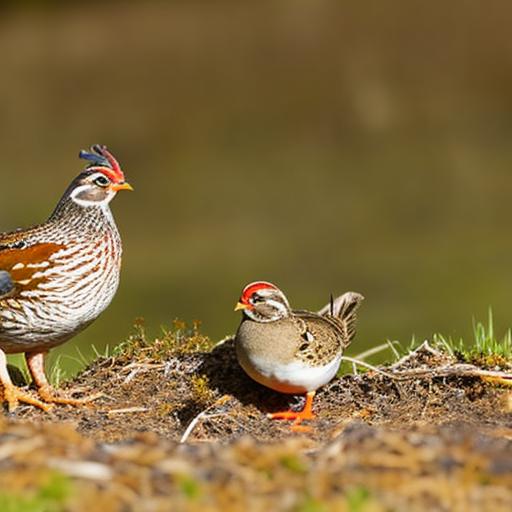When it comes to raising quail and chickens, understanding their space requirements is crucial for their health and well-being. Quail are smaller birds that require less space compared to chickens. For quail, it is recommended to provide at least 1 square foot of space per bird in the coop. This allows them to move around comfortably and exhibit natural behaviors such as dust bathing and foraging. On the other hand, chickens require more space due to their larger size and more active nature. A general rule of thumb is to provide 2-3 square feet of space per chicken in the coop, depending on the breed and size of the birds.
In addition to the coop space, outdoor space is also important for both quail and chickens. Quail are ground-dwelling birds and prefer to have access to a secure outdoor area where they can forage and explore. Providing at least 2-3 square feet of outdoor space per quail is ideal. Chickens, on the other hand, are more active foragers and require more outdoor space. It is recommended to provide at least 8-10 square feet of outdoor space per chicken to allow them to roam, scratch, and peck for insects and plants. Understanding these space requirements is essential for creating a suitable living environment for quail and chickens.
Key Takeaways
- Quail require at least 1 square foot of space per bird, while chickens need 2-3 square feet per bird.
- Factors to consider when determining the distance between quail and chickens include their size, behavior, and the availability of resources such as food and water.
- Providing adequate space for quail and chickens is important for their physical and psychological well-being, as well as for preventing aggression and disease.
- Overcrowding can lead to stress, aggression, and the spread of diseases among quail and chickens.
- Creating the ideal living environment for quail and chickens involves providing proper space, ventilation, and access to food and water, as well as minimizing stress factors.
Factors to Consider When Determining the Distance Between Quail and Chickens
When determining the distance between quail and chickens, there are several factors to consider to ensure the well-being of both species. One important factor is the size and activity level of the birds. Quail are smaller and less active compared to chickens, so they require less space both in the coop and outdoor area. It is important to take into account the individual space requirements of each species when planning the layout of the coop and outdoor space.
Another factor to consider is the behavior of quail and chickens. Quail are ground-dwelling birds that prefer to stay close to the ground, while chickens are more active and may spend more time exploring higher areas such as perches. When designing the living environment for both species, it is important to provide suitable structures such as low perches for quail and higher perches for chickens to accommodate their natural behaviors.
Additionally, the compatibility of quail and chickens should be taken into consideration when determining the distance between them. While they can coexist in the same living environment, it is important to provide enough space to prevent overcrowding and potential conflicts between the two species. By considering these factors, it is possible to create a harmonious living environment for quail and chickens.
The Importance of Providing Adequate Space for Quail and Chickens
Providing adequate space for quail and chickens is crucial for their overall health and well-being. When birds are overcrowded or do not have enough space to move around, it can lead to stress, aggression, and a higher risk of disease transmission. Adequate space allows birds to exhibit natural behaviors such as foraging, dust bathing, and socializing, which are essential for their mental and physical health.
In addition, providing enough space can help prevent injuries and health issues related to overcrowding. When birds are cramped in a small space, they may become more prone to pecking and aggression, which can result in injuries and feather loss. Furthermore, overcrowding can lead to poor air quality in the coop, increasing the risk of respiratory issues and other health problems.
By providing adequate space for quail and chickens, it is possible to create a more comfortable and healthy living environment for the birds. This can lead to better overall welfare, improved egg production, and a lower risk of disease outbreaks. Understanding the importance of space requirements for quail and chickens is essential for responsible bird keeping.
How Overcrowding Can Affect the Health and Well-being of Quail and Chickens
Overcrowding can have detrimental effects on the health and well-being of quail and chickens. When birds are overcrowded in a small space, it can lead to stress, aggression, and an increased risk of disease transmission. Overcrowding can also result in poor air quality in the coop, which can lead to respiratory issues and other health problems.
In addition, overcrowding can lead to behavioral issues such as feather pecking and cannibalism. When birds do not have enough space to move around and exhibit natural behaviors, they may become more prone to aggressive behaviors towards each other. This can result in injuries, feather loss, and a decrease in overall welfare.
Furthermore, overcrowding can impact egg production and quality in both quail and chickens. When birds are stressed due to overcrowding, it can lead to a decrease in egg production and an increase in abnormal eggs. Providing adequate space for quail and chickens is essential for preventing these negative effects on their health and well-being.
Tips for Creating the Ideal Living Environment for Quail and Chickens
Creating the ideal living environment for quail and chickens involves several key considerations to ensure their health and well-being. One important tip is to provide enough space both in the coop and outdoor area to accommodate the individual space requirements of each species. This includes providing at least 1 square foot of space per quail in the coop, 2-3 square feet of outdoor space per quail, 2-3 square feet of space per chicken in the coop, and 8-10 square feet of outdoor space per chicken.
Another tip is to provide suitable structures and enrichment for both quail and chickens. This includes offering low perches for quail to accommodate their ground-dwelling nature, as well as higher perches for chickens to satisfy their natural instinct to roost. Providing areas for dust bathing, access to fresh water, and a balanced diet are also essential for creating an ideal living environment for both species.
Furthermore, maintaining good hygiene practices such as regular cleaning of the coop, providing proper ventilation, and monitoring the health of the birds are important tips for creating a healthy living environment. By following these tips, it is possible to create a suitable living environment that promotes the health and well-being of quail and chickens.
Monitoring and Adjusting the Distance Between Quail and Chickens

Monitoring the distance between quail and chickens is important for ensuring their well-being in a shared living environment. Regular observation of the birds’ behavior can provide valuable insights into whether they have enough space or if adjustments need to be made. Signs of stress, aggression, or abnormal behaviors can indicate that the distance between quail and chickens may need to be adjusted.
It is also important to monitor the overall health of the birds when determining the distance between them. Regular health checks can help identify any signs of disease or injury that may be related to overcrowding or inadequate space. Adjusting the distance between quail and chickens may be necessary if there are any health concerns related to their living environment.
In addition, making adjustments to the living environment such as adding more perches or providing additional outdoor space can help ensure that both quail and chickens have enough room to move around comfortably. By monitoring their behavior and health, it is possible to make informed decisions about adjusting the distance between quail and chickens to promote their well-being.
Finding the Right Balance for Keeping Quail and Chickens at a Safe Distance
In conclusion, understanding the space requirements for quail and chickens is essential for creating a suitable living environment that promotes their health and well-being. Factors such as size, activity level, behavior, and compatibility should be considered when determining the distance between quail and chickens. Providing adequate space is crucial for preventing overcrowding-related issues such as stress, aggression, disease transmission, injuries, and decreased egg production.
By following tips such as providing enough space, suitable structures, enrichment, hygiene practices, and monitoring their behavior and health, it is possible to create an ideal living environment for both quail and chickens. Regular monitoring of the distance between quail and chickens can help ensure that adjustments are made as needed to promote their well-being in a shared living environment. Finding the right balance for keeping quail and chickens at a safe distance is key to responsible bird keeping and ensuring their overall welfare.
If you’re looking for advice on how to care for your quail and chickens, you might find the article “How to Care for Goslings” on PoultryWizard.com particularly helpful. This comprehensive guide offers valuable insights into raising and caring for young geese, which can also provide useful tips for keeping your quail and chickens healthy and happy. Check out the article here to learn more about creating a nurturing environment for your feathered friends.
FAQs
What is the recommended distance to keep quail and chickens apart?
The recommended distance to keep quail and chickens apart is at least 50 feet. This helps to prevent the spread of diseases and reduces the risk of aggression between the two species.
Why is it important to keep quail and chickens at a distance from each other?
It is important to keep quail and chickens at a distance from each other to minimize the risk of disease transmission. Quail and chickens can carry different diseases that may not affect each other, but can be harmful if transmitted to the other species.
Can quail and chickens be kept in the same coop or pen?
It is not recommended to keep quail and chickens in the same coop or pen. They have different space and environmental requirements, and keeping them together can lead to stress, aggression, and potential disease transmission.
What are the potential risks of keeping quail and chickens too close together?
Keeping quail and chickens too close together can increase the risk of disease transmission, as well as potential aggression and stress between the two species. This can lead to decreased overall health and productivity of the birds.
Are there any exceptions to the recommended distance for keeping quail and chickens apart?
In some cases, if proper biosecurity measures are in place and the birds are closely monitored for signs of disease, it may be possible to keep quail and chickens closer together. However, it is generally best to follow the recommended distance of at least 50 feet to minimize risks.
Meet Walter, the feathered-friend fanatic of Florida! Nestled in the sunshine state, Walter struts through life with his feathered companions, clucking his way to happiness. With a coop that’s fancier than a five-star hotel, he’s the Don Juan of the chicken world. When he’s not teaching his hens to do the cha-cha, you’ll find him in a heated debate with his prized rooster, Sir Clucks-a-Lot. Walter’s poultry passion is no yolk; he’s the sunny-side-up guy you never knew you needed in your flock of friends!







